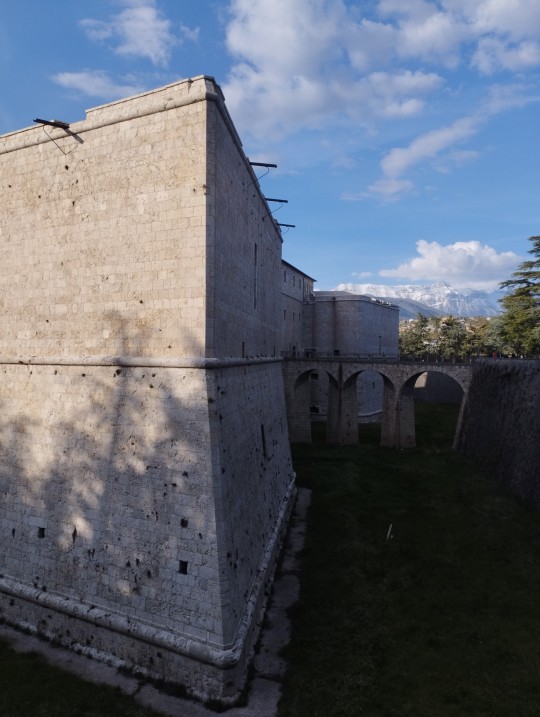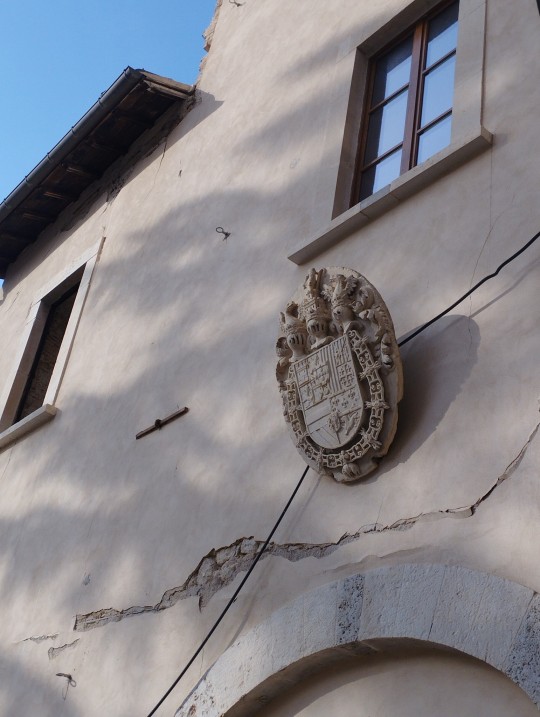#STEMMA
Explore tagged Tumblr posts
Text

TCS34303 - tri-stimulus color sensor 🔧🌈📸
This weekend, we whipped up a Stemma QT breakout board for the TCS34303 (https://www.digikey.com/en/products/detail/ams-osram-usa-inc/TCS34303-OLGA8-LF-T-RDP/7428283) a 'tri-stimulus' color sensor. Most color sensors we've stocked have a red/green/blue/clear diode. This sensor can provide CIE 1931 XYZ output, useful for color correction, or photo/videography. To make it like our old TCS34725 (https://www.adafruit.com/product/1334), we added a white neutral LED. Since it has a 1.8V sensor, we had to add a lot of level shifting to make it compatible with 3 or 5V power and logic. Coming soon.
#adafruit#TCS34303#stemma#color#sensor#tri-stimulus#colorcorrection#photography#videography#electronics#engineering#tech#diyprojects#makercommunity#sensors#development
46 notes
·
View notes
Text









Forte Spagnolo (Castello Cinquecentesco) - L'Aquila
#pensieri per la testa#persa tra i miei pensieri#fotografia#foto#scatto fotografico#l'aquila#abruzzo#abruzzese#castello#castello cinquecentesco#forte spagnolo#fortezza#stemma#storia#arte#cultura#architettura
9 notes
·
View notes
Text
io sono lo stemma

#famigliacarta#oristano#sardegna#ballettesavary#polvere#1800s#painting#eagle#stemma#coat of arms#vintage
3 notes
·
View notes
Text
In Via Panicale uno stemma per l'esorcismo


Accanto all’ex convento di Sant’Orsola, in Via Panicale, sulla facciata dell’edificio si può vedere un antico stemma in pietra serena. E’ uno stemma rotondo che rappresenta due croci benedettine. Queste croci sono caratterizzate dalla presenza di tre gemme ad ogni estremità, che simboleggiano Cristo con i dodici apostoli. Questo stemma era posto sopra il portone di ingresso al monastero. Il complesso edilizio nacque nel 1309 come appendice della basilica di San Lorenzo ed era abitato dalle suore benedettine, dal 1327 al 1435. Va premesso che San Benedetto da Norcia, fondatore dell’ordine, è il patrono degli esorcisti. Il monastero nacque proprio nel momento storico che decreta la fine dei Templari. Papa Clemente V (che trasferì la sede papale ad Avignone), ricordato come pontefice avido e simoniaco, dedito alla lussuria, sostenne che Dio, in una visione, lo avesse avvisato che i Templari erano eretici, colpevoli di adorazione del diavolo, omosessualità, vilipendio della croce, sodomia ed altri comportamenti blasfemi; i loro incontri erano segreti e si diffusero voci riguardo a bizzarri riti di iniziazione, che contribuirono moltissimo a diffondere sospettosità da parte del pubblico verso l’ordine. Per questi motivi Clemente V dette ordine di catturare tutti i Templari, li fece sottoporre a torture indicibili per far loro confessare i crimini contro Dio; molti morirono bruciati come eretici e l’ordine venne soppresso con bolla papale del 3 aprile 1312.

Lo stemma di Via Panicale è a forma di cerchio, che sta proprio a significare la presenza femminile nel monastero. Lo stemma nasconderebbe una formula antica, ogni lettera dell’iscrizione presente sulla medaglia è parte integrante di un esorcismo antichissimo, apparso in un manoscritto del XIV secolo, a testimonianza della fede nella potenza di Dio e di San Benedetto. In alto vi sono incise delle lettere “I e N”, che si riferiscono ad entrambe le croci, mentre negli angoli della prima croce sono incise le lettere “S-C-R-D” e della seconda croce le lettere “C-O-I-A”. Complessivamente le iscrizioni dovrebbero significare: In Nomine Sanctae Crucis Rejecta Daemonum e In Nominae Crucis Observationis Induce Amorem, cioè: “In Nome della Santa Croce Ripudia il Demonio” e “In Nome dell’Osservanza della Croce Induci l’Amore”, quindi si tratta di un invito a rifiutare il Male e a perseguire il Bene, dunque un esorcismo in piena regola. Quelle scritte, con tutta probabilità, avevano il compito di proteggere le suore che alloggiavano nel monastero.

Gabriella Bazzani Madonna delle Cerimonie Read the full article
0 notes
Text
Gli stemmi del Portale di San Gregorio a Pietracupa



Forse in questo studio, la parte più difficile, la si è trovata nel tentativo di date una connotazione alle due insegne gentilizie, che si pongono ai due lati dell'Agnus Dei, nell'architrave trecentesca della chiesa si San Gregorio, alle porte di Pietracupa.
Uno scudo liscio, tipico del basso medioevo, con tre caprioli sormontati da due rosette, in campo rosso, apparentemente dalle tracce di pigmento purpureo, in tutto il pezzo.
Nonostante si siano consultati tutti gli armoirali, codici araldici ed eventuali compendi delle nobili famiglie del Regno di Napoli, non si è riusciti a trovare assolutamente nulla che possa chiarirci le idee sulla loro origine, se non alcune idee di carattere empirico, e da trattare con le pinze volendo.
Già mesi fa, si era discusso di una probabile appartenenza al committente Roberto di Pietracupa, feudatario di questa terra, al tempo.
Nulla si sa di certo sul suo conto, delle informazioni frammentarie, che non danno neppure possibilità di conoscere il suo casato di appartenenza, di origine verosimilmente francese.
Però, gli attributi di questi blasoni non sono estranei al contesto della Regione, visto che tra le signorie feudali, vi era quella dei "de Ligny" o "d'Alagno", signori di Campochiaro, e muniti di uno stemma con tre caprioli in campo rosso.
Questa peculiarità, ha permesso di ipotizzare, che Roberto di Pietracupa, potrebbe essere appartenuto al casato francese di Ligny, oppure esser parte di una signoria collaterale, con caratteristiche araldiche, davvero simili, come si può vedere nello stemma del palazzo Ruffo di Napoli, in basso a destra.
Un'altra informazione ci era giunta tramite una chiacchierata, diversi mesi fa, con il parroco don Orlando Di Tella, che rammentava di aver visto, alcuni anni addietro, l'insegna di una famiglia che ebbe a che fare con Venafro.
Egli non aveva torto in effetti, perché tra i principi di Venafro, risultano essere annoverati gli Spinelli, del cui ramo, quello di Giovinazzo, era in origine composto da una spina di pesce, sormontata da due rosette, in campo rosso, molto simile, ma totalmente diverso dal contesto precedente, facendoci restare fermi, al momento, sulla nostra prima ipotesi.
#arte#italia#medioevo#storia#archeologia#cultura#storia dell'arte#molise#pietracupa#Stemmi#Araldica#Regno di Napoli#Blasone#Stemma#de Ligny
0 notes
Text
Il Registro Araldico Italiano e l’eredità degli antenati
Il Registro Araldico Italiano (RAI) ha pubblicato la sua seconda versione cartacea. Dalla sua nascita, nel 2007, in cui si costituiva come archivio sia cartaceo che digitale, il RAI ha registrato il suo articolo di censimento numero 700. Con questo autorevole traguardo raggiunto il RAI ha pubblicato un secondo volume cartaceo. Di per sé, come oggetto, il volume si presenta già adeguato alla…

View On WordPress
#agomagia#Cavalieri#Ghibellini#Guelfi#lamagiadellago#RAI#Registro Araldico Italiano#Scienze Antiche e Araldiche#stemma#Vittorio Veneto
0 notes
Text
apparatus criticus would be a beautiful name for a baby girl
54 notes
·
View notes
Note
Non capisco perchè il video di Tonali che guarda San Siro ha un sacco di commenti del tipo "Ci manchi Sandro" "Torna Sandro" "Ti vogliamo tanto bene" però quando Gigio torna a giocare a San Siro con la Nazionale sono solo fischi e insulti.
i piu grandi misteri della fede, anon, sono:
Unità e Trinità di Dio
Incarnazione, Passione, Morte e Risurrezione di Nostro Signore Gesù Cristo
Il trattamento riservato a Gigione diverso da quello riservato a Sandrino nonostante abbiano fatto le stesse scelte di carriera palesemente guidate dalla stessa forza: il cash
#sandrino e' un santo che un giorno ritornera al Milan ma Gigione deve morire#NESSUNO ha capito perche'#sono passati 300 anni dalla scelta di gigio e ancora viene fischiato allo stadio pero sandrino che se ne va con le stesse motivazioni#viene applaudito ????#anche io sono molto confusa#senza contare che la gente ancora non ha capito che di bandiere ormai ce ne sono POCHISSIME#e calciatori giovani come loro saranno sempre dei mercenari per il momento#e probabilmente per tutta la carriera#voglio dire guardate ibrahimovic prima di cominciare a rovesciare tavoli e dire ITALIA E' MILAN#ha cambiato piu squadre di lukaku e baciato lo stemma di qualsiasi team come se sua nonna l'avesse fondato#la natura del calcio a grandi livelli e' questa purtroppo#gigione e sandro non hanno fatto niente di strano i tifosi lo devono capire e soprattutto non fare differenze per nulla#e aggiungo che io NON milanista vorrei vedere entrambi tornare perche penso che possono essere grandissimi giocatori per il milan
5 notes
·
View notes
Text
i need to draw l. furius with his imagines at some point really bad also
#they are a very important part of how i picture any scenes that take place in (the atrium of) his house....#the creepy translucent wax faces of his ancestors staring out....#ficposting#i still dont know if i think they were masks or just wax busts personally but i like the necromancy aspect of the masks enormously so#i think i will interpret them as masks when i write/draw.#oh and also the stemma(family tree)....
5 notes
·
View notes
Note
13, 23, 37?
13: "Genesis 19: 1-2" by The Mountain Goats
23: "Be" by Hozier
37: "Murder at the 18th St. Garage" by The Mountain Goats
#incredible coincidence that nate--author of famed pentiment fic Stemma Codicum--sniped the goats song about sodom and gomorrah#and I'll tell you no lies#astriiformes#spotify wrapped
5 notes
·
View notes
Text
🚨 New This Week at Adafruit! 🚨
🌟 Adafruit INA3221 - Triple 0-26VDC, ±3.2A Power Monitor - STEMMA QT / Qwiic 💼 Engineer Professional Silicone-Tip Solder Sucker ⚡️ USB Type C PD to 5.5mm/2.1mm Barrel Jack Adapter - 20V 🔌 USB C to USB C Cable w/ 100W Watt Display - 2m Black Woven
Shop now! 🛒 https://adafruit.com
#adafruit#electronics#STEMMA#STEMMAQT#INA3221#powermonitor#usbC#STEM#engineering#maker#diy#usbpd#usbtypec#usbcables#cables#soldering#soldertools#siliconesucker#poweradapter#5V#20V#makerspace#tech#hardware#engineeringtools#electronicsprojects#openhardware#electronicsmaker#innovation#electronicsdesign
8 notes
·
View notes
Text










#pensieri per la testa#persa tra i miei pensieri#fotografia#foto#scatto fotografico#rocca Ubaldinesca#rocca Sassocorvaro#Sassocorvaro#rocca#architettura#rilievo#bassorilievi#fratelli#storia#Ottaviano degli Ubaldini#Federico da Montefeltro#arte#parità#guerra#pace#sapere#conoscenza#alchimia#stemmi#stemma#simboli#libreria#Marche
2 notes
·
View notes
Text
I feel sort of weird tossing up the first chapter of a new multichapter fic when I have 1) two actively in-progress WIPs and 2) an exchange gift I haven't completely finished for the same fandom as the fic, but what's actually happened here is that I started writing what I thought was going to be a oneshot with several different vignettes in it back in December and have since decided to split it up, so now I have two already-completed chapters just sitting there
Anyways I could kind of use some "posting things" energy in my life right now, so I think I might throw the first chapter up sometime tomorrow and plead people's mercy re: "starting" something new before updating either of my other fics. Some of us just live our lives like this. Unfortunately.
#what's funny is technically it's the first pentiment fic i started#but then i realized it was going to be longer than the other one#so i turned my focus towards 'stemma codicum' instead#i suppose i should be fair to myself and point out that's one of the other WIPs and will only have one more chapter#also: pentiment streaming gang i am pointing a spray bottle in your direction. this fic has big act iii spoilers#soon. you will be able to read my fics soon#but not yet
13 notes
·
View notes
Text






coat of arms scarpi de claricini
scarpi de claricini coat of arms
scarpi de claricini wappen
scarpi de claricini
stemma scarpi de claricini
wappen scarpi de claricini
#coat of arms scarpi de claricini#scarpi de claricini coat of arms#scarpi de claricini wappen#scarpi de claricini#stemma scarpi de claricini#wappen scarpi de claricini
0 notes
Text
L’ombra della massoneria sulle Assemblee di Dio in Italia (ADI): 22) Lo stemma delle Assemblee di Dio in Italia è opera di un massone? Giudicate voi
L’ombra della massoneria sulle Assemblee di Dio in Italia (ADI): 22) Lo stemma delle Assemblee di Dio in Italia è opera di un massone? Giudicate voi Introduzione Prima di passare a trattare quest’altro argomento, voglio fare una breve premessa che è questa. Se c’è una religione in cui i simboli rivestono un ruolo molto importante, se non fondamentale, questa è la Massoneria, che usa i simboli…

View On WordPress
#(A.D.I.) Assemblee di Dio in Italia#Butindaro Giacinto#Massoneria#Ombra della Massoneria nelle Assemblee di Dio in Italia (A.D.I.)#Stemma delle ADI
0 notes